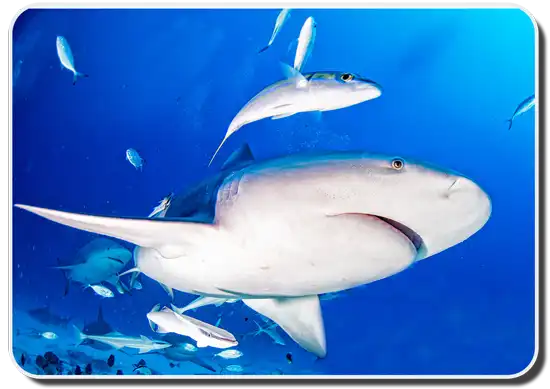Though some television shows and movies might have you believe that sharks lay in wait to devour a tasty human, these are much exaggerated facts about sharks. Though sharks do attack humans on occasion, it’s actually a rare occurrence when you consider the multitudes of shark species out there and the millions of people who enter the waters each day around the world. 2015 set a new world record for shark attacks when 98 incidents were logged; 6 of them fatalities. So far in 2016, there have been 69 attacks by sharks on humans worldwide with another 6 fatalities. This is still relatively low when you consider that 35 people in the U.S. alone have died from being struck by lightning just this year.

Where Do Humans Fit In?
One thing is for certain, when humans do get bitten by a shark, it isn’t for feeding purposes. Typically, sharks who patrol the shallow waters where people swim and surf will ignore humans. However, sometimes certain things can grab their attention and curiosity such as brightly colored swimsuits, flashy jewelry, or even an open wound. At that point the shark might come in to take a closer look and if it is an aggressive species, they might take a bite just to check you out. Once they figure out that you are not on their menu, they’ll spit you out and swim away.
As A Matter Of Fact, They Eat Many Things!
So if sharks don’t eat us, then what do they eat? Well, that depends on the type of shark in question and the type of food that is available where they live and feed. Sharks can eat fish, plankton, mollusks, crustaceans, squid, rays, dolphins, sea turtles, sea lions; practically anything you can find in the ocean would make a meal for some species of shark. Some sharks, like the Bull Shark, even eat other sharks! Other sharks, like the Tiger Shark, will eat non-food sources that end up in the sea such as garbage and waste. Some have even been found with vehicle license plates in their stomachs. This goes to show how dangerous pollution can be to our ecosystem, whether we know it or not.
Facts About Sharks’ Feeding Style
Some sharks are filter feeders, like the Whale Shark, the Megamouth, and the Basking Shark. You could consider their feeding method to be like a strainer that you use in the kitchen. They just open wide and suck in a huge mouthful of water. They then expel the water back out through their gills and keep the food sources in, usually plankton.
Bottom feeders hang out on the bottom of the ocean and use their upper jaw to pick up prey as their mouths are situated on the underside of their head. The Horn Shark, for instance, uses his pointed front teeth to grasp while he uses his back molar-like teeth for crushing it. The Saw Shark and the Zebra Shark also bottom-feed and lie in wait for an unassuming fish or shell fish to come along and become dinner.
Most types of predatory sharks, such as the Great White, will tear their food into chunks to devour whole without chewing. Some sharks, like the Port Jackson, might use their flat back teeth to grind food before swallowing.
The Unique Feeders
Some sharks use techniques that are quite unique when compared with most other sharks. Hey, we all have our own routines when it comes to dinnertime!
- The Thresher Shark uses its extra-long tail to round up schools of fish for easier eating.
- The Nurse Shark uses his thick lips to create a suction effect to suck prey out of crevices and holes.
- The Cookiecutter Shark suctions itself to large fishes and even whales to bite out a piece of flesh to eat.
- The Pygmy Shark swims back-and-forth across the ocean floor, totaling 11 km (or 7 miles), to get its nightly feeding.
Who Eats Sharks?
With all of these facts about sharks feeding habits, some people might wonder; does anyone eat sharks? While we have already mentioned that bull sharks will eat other sharks, what about other ocean dwellers? Though many people think that sharks are at the top of the food chain, this isn’t always the case. Some documented cases include:
- Killer whales have been known to attack and kill Great Whites
- Crocodiles can eat Bull Sharks
- An osprey ate a Bonnethead Shark
- Sea lions can eat Leopard Sharks
- A goliath grouper ate a Blacktip Reef Shark
Though some of these cases are isolated, one wonders just what goes on in places where the cameras do not roll.
The Biggest Threat
Of course, the biggest threat to sharks does not live in the ocean. It lives on land and it is man. Humans catch and kill sharks at such alarming rates that some are endangered and some are on the very brink of extinction. Some people catch sharks for their fins, their oils, their meat, or anything that they can take. And the more we mess with them, the more we mess with the ecosystem.
What sharks eat are what keeps the ocean running the way it should. Many sharks eat the sick and weak members of certain species, leaving the healthy ones to reproduce and thrive. Other sharks eat the carcasses of dead creatures that litter the ocean floor, keeping it clean. Without sharks, the ocean would be a mess and if the ocean becomes a mess, so will the entire planet and everyone living on it. So be happy that sharks eat what they do, be happy about what they don’t, and let’s all try to get along.
